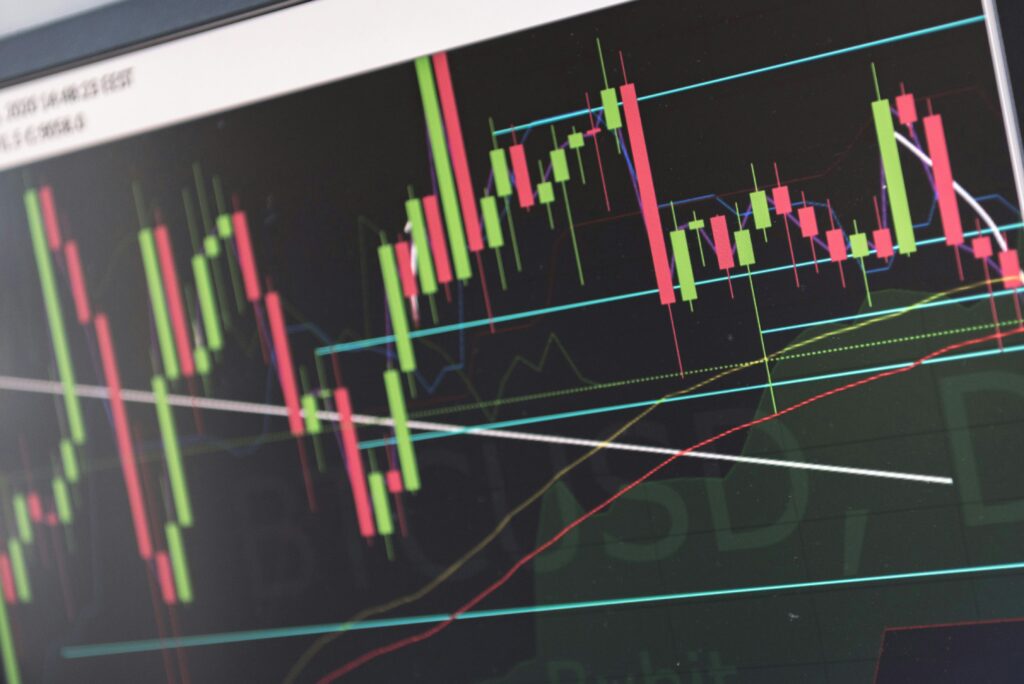How to Analyze Cryptocurrency Market Trends for Better Investment Decisions
Understanding the Basics of Cryptocurrency Market Analysis

Understanding the Basics of Cryptocurrency Market Analysis
Cryptocurrency market analysis is an essential skill that every investor or trader in the crypto world should possess. It involves evaluating and interpreting various factors to make informed decisions about buying, selling, or holding cryptocurrencies. Here are some fundamental concepts to help you gain a better understanding of the basics of cryptocurrency market analysis:
- Historical Price Data:
Understanding historical price data is crucial as it helps identify and analyze patterns, trends, and cycles within the cryptocurrency market. Analyzing past price movements enables investors to make predictions about potential future price actions. - Technical Analysis:
Technical analysis is a widely used approach to analyzing markets. It involves studying market data, such as price charts and indicators, to predict future price movements. Indicators may include moving averages, volume, relative strength index (RSI), and more. - Fundamental Analysis:
Apart from technical analysis, fundamental analysis is another method used to evaluate cryptocurrencies. It requires assessing qualitative and quantitative factors such as project team strength, partnerships, adoption rates, technological advancements, regulatory environment, and overall market sentiment. - Market Cap:
The market capitalization (market cap) of a cryptocurrency refers to its total value in the market. It is calculated by multiplying the total supply of coins or tokens by their current price. Market cap provides an overview of the size and potential value of a cryptocurrency compared to others in the market. - Trading Volume:
Trading volume represents the total number of shares or units traded within a specific timeframe. High trading volume indicates increased market activity and liquidity, making it easier for investors to buy or sell their assets. Lower trading volumes can indicate stability but may also suggest less interest or potential volatility. - Supply and Demand Dynamics:
Cryptocurrencies experience fluctuations in price due to variations in supply and demand. Increased demand or decreased supply tends to drive prices higher, while decreased demand or increased supply may result in price declines. Understanding these dynamics is crucial for analyzing potential price movements. - Market Sentiment:
Market sentiment refers to the general psychological and emotional attitude of investors towards a particular market or asset. Positive sentiment often leads to price increases as more investors opt to buy, while negative sentiment may drive prices downward as more investors sell. Analyzing market sentiment helps gauge overall interest and potential price movements. - News Impact:
The crypto market is highly influenced by news events, such as technology updates, legal and regulatory changes, global economic events, or partnerships announcements. Traders and investors keenly analyze news for potential impacts and adapt their strategies accordingly. - Risk Management:
Risk management is an essential aspect of cryptocurrency market analysis. It involves setting entry and exit points, defining stop-loss levels, diversifying portfolios, and limiting exposure to minimize potential losses. Implementing effective risk management techniques helps protect investments in a highly volatile market.
In conclusion, understanding the basics of cryptocurrency market analysis allows investors to make informed decisions and navigate the dynamic world of cryptocurrencies more effectively. Combining technical and fundamental analysis with an awareness of market factors can provide valuable insights into potential crypto investments. Stay updated with relevant news, continuously refine your analytical skills, and adapt to changing market trends for long-term success in the ever-evolving realm of cryptocurrency trading.
Exploring Fundamental Analysis in the Crypto Space
Exploring Fundamental Analysis in the Crypto Space
Fundamental analysis is an essential toolkit for investors and traders in any financial market, including the crypto space. Unlike technical analysis that relies on charts and patterns, fundamental analysis involves assessing the intrinsic value of an asset based on its underlying factors and economic conditions. In this guide, we will delve into the key concepts and techniques of fundamental analysis when applied to the cryptocurrency market.
Understanding Market Cap: Market capitalization plays a crucial role in crypto fundamental analysis. It represents the total value of a cryptocurrency and can offer insights into its growth potential, as well as its relative size within the market. High market caps generally indicate established cryptocurrencies while lower market caps represent smaller, potentially volatile assets.
Examining Technology & Innovation: One significant aspect of fundamental analysis in cryptocurrencies is focusing on innovation and technology behind a particular project or blockchain. Understanding how a cryptocurrency operates, its features, consensus mechanism, scalability solutions, and security measures can help form informed opinions about its long-term viability.
Evaluating Development Team & Community: Assessing the strength and competency of a project’s development team is critical in determining the long-term prospects of a cryptocurrency. Investigating their experience, contributions, transparency, partnerships, and community engagement is crucial to ascertain whether they can deliver on their promises.
Analyzing Product Adoption & Use Cases: The real-world adoption of a cryptocurrency and its potential use cases are pivotal factors in fundamental analysis. Investigating partnerships, collaborations, and implementations by businesses across various industries offers valuable insights on utility, adoption rates, and future potential.
Considering Regulatory Environment: Regulatory developments play a substantial role in shaping the crypto landscape. Analyzing the regulatory environment surrounding cryptocurrencies in different countries can provide critical information about investment risks, potential hurdles for widespread adoption, as well as legal considerations for investors.
Monitoring Industry Trends & News: Staying abreast of cryptocurrency news and industry trends is indispensable for effective fundamental analysis. Monitoring press releases, news articles, industry forums, social media discussions, and expert opinions aids in identifying shifts in market sentiment, major developments, or potential catalysts that may influence a cryptocurrency’s performance.
Assessing Market Liquidity: Market liquidity is significant when analyzing cryptocurrencies. By assessing trading volumes and liquidity across various exchanges, investors can gain insights into how easily they can buy or sell a particular cryptocurrency without significantly impacting its price. High liquidity indicates a more active market with relatively smoother transactions.
Accounting for Risk & Security: Fundamental analysis should consider risk factors and security aspects associated with cryptocurrencies. Assessing the vulnerability to cyber attacks, code audits, past security breaches, and overall reputation among users and developers enables investors to make better-informed investment decisions.
In conclusion, fundamental analysis in the crypto space involves evaluating various essential aspects such as market cap, technology, development team, adoption rates, regulations, industry trends, liquidity, risk factors, and security measures. Conducting thorough research using these fundamental analysis techniques can provide a comprehensive understanding of a cryptocurrency’s potential prospects within the broader market context. It is crucial to remember that fundamental analysis should be utilized alongside other forms of analysis and not in isolation for robust investment strategies and decision-making in the volatile world of cryptocurrencies.
An Introduction to Technical Analysis for Cryptocurrency Trading

Technical analysis is a popular trading technique employed by cryptocurrency traders to predict future price movements. This approach revolves around studying historical market data such as price and volume, seeking patterns and trends to make informed trading decisions. By analyzing charts and indicators, traders attempt to gain insights into market sentiment and make more efficient trades.
There are numerous chart types utilized in technical analysis, with candlestick charts being the most common one for cryptocurrencies. Candlestick charts display price movements over a period of time as colored rectangular shapes called “candles.” The candles’ body color indicates whether the cryptocurrency’s price increased or decreased within that timeframe, while their upper and lower bounds, known as wicks or shadows, represent the highs and lows.
In addition to charts, technical analysis employs various indicators that provide further insight. These indicators can be classified into categories like trend-following, momentum, volatility, and volume-based indicators. Moving averages are commonly used trend-following indicators that smooth out price fluctuations over a defined period, aiding in identifying potential trends.
Momentum indicators gauge the speed of price movement and identify potential areas of overbought or oversold conditions. Some renowned momentum indicators include the Relative Strength Index (RSI), Stochastic Oscillator, and Moving Average Convergence Divergence (MACD). These indicators help traders determine when an asset may be due for a correction or a reversal in trend.
Volatility indicators assist in measuring the range of price fluctuations. One widely-used volatility indicator is Bollinger Bands, which consist of three lines plotted based on recent price data. Staying within the range created by these bands generally indicates relative price stability, while breaking out of them suggests increased volatility.
Finally, volume-based indicators analyze market activity by considering trading volumes alongside price movements. By scrutinizing volume spikes or divergences from price trends, these indicators help traders assess market strength or potential reversals.
It is important to remember that technical analysis is not foolproof and should be combined with other forms of analysis for more comprehensive decision-making. While past price patterns can indicate potential future movements, they do not guarantee accurate predictions.
Ultimately, technical analysis serves as a valuable tool in the cryptocurrency trader’s toolbox, empowering them to assess market sentiment and identify potential trading opportunities. By understanding basic concepts like candlestick charts, trend-following indicators, momentum indicators, volatility indicators, and volume-based indicators, traders can gain practical insights to optimize their trading strategies.
Using Social Media and News Sentiments to Gauge Market Trends

Using Social Media and News Sentiments to Gauge Market Trends
Social media platforms have revolutionized communication, forming a vital part of our daily lives. But beyond personal interactions and networking, they also serve as invaluable tools for gauging market trends and sentiments, especially within the crypto industry.
News travels fast on social media, with stories breaking in real time and quickly going viral. Successful cryptocurrency traders recognize that monitoring social media channels allows them to stay informed about the latest news developments and market sentiment around a particular cryptocurrency. Whether it’s Twitter, Reddit, or specialized crypto discussion forums, these platforms host conversations where traders share their thoughts, news articles, opinions, charts, and more.
By actively engaging with various crypto communities on these platforms, traders are able to get firsthand accounts of breaking news or emerging trends shaping the market. Analyzing the collective sentiment expressed within these communities can provide valuable insights into the potential price impact of certain events or announcements.
Positive sentiment surrounding a particular cryptocurrency often correlates with rising prices and increased trading volumes. On the other hand, negative sentiment can lead to a decline in prices. Monitoring social media sentiment can act as an early warning system for potential market movements before they manifest in large buying or selling volumes.
News sentiments play a critical role in assessing market trends as well. Traders scour the internet for reputable news sources to keep up to date with key industry-related events. Following reputed media outlets, cryptocurrency news websites, and dedicated crypto influencers can provide traders with real-time updates on new blockchain projects, regulatory developments, partnerships, and even potential market manipulation attempts.
Besides staying informed about crucial news events, tracking the sentiment reflected in media coverage is equally important. News sentiments can create waves within the market as investors react based on perceived information or misinterpretations. Positive news may generate optimism, fueling buying frenzies and subsequent price increases. Conversely, negative news reports might trigger panic sell-offs leading to sharp price declines. Observing trends in news coverage, analyzing the nature of sentiment, and cross-referencing it with social media discussions can give an indication of overall market excitement or nervousness.
Even though social media can provide valuable insights into market trends and sentiments within the crypto industry, it is important to approach this information with caution. Not all sources are accurate or reliable, as manipulation and misrepresentations are widespread. Traders should be able to differentiate between factual news, opinions, and even market manipulation attempts to make informed trading decisions.
By effectively harnessing the power of social media platforms and closely monitoring news sentiments, cryptocurrency traders can gain a competitive edge in anticipating market trends and making insightful investment decisions in this ever-evolving industry.
The Importance of Volume in Analyzing Crypto Markets

Analyzing the crypto markets requires paying close attention to various indicators and metrics, one of which is volume. Volume refers to the total number of shares or coins traded within a particular time frame. It reveals the significance and intensity of market activity for specific cryptocurrencies.
First of all, volume serves as a reflection of market liquidity. In simpler terms, it demonstrates the ease and speed with which a cryptocurrency can be bought or sold without causing significant price fluctuations. Higher trading volumes generally indicate better liquidity, implying that a substantial number of participants are actively engaging in buying and selling cryptocurrencies.
Moreover, volume aids in validating trends observed in the crypto markets. Changes in trading volume often accompany significant price movements. For instance, if the price is increasing along with higher volume, it suggests a stronger bullish trend. Conversely, declining prices combined with high volume could illustrate bears asserting control over the market sentiment.
Analyzing volume patterns can also assist in identifying potential price reversals or consolidations. Unusually high volume during periods of price stability might suggest that investors are reaching a consensus before initiating the next major price move. On the other hand, low trading volumes during sharp price fluctuations could indicate uncertain market sentiments.
Additionally, comparing trading volumes across different time periods can be informative to detect shifts in market interest. An increase or decrease in volume compared to previous periods might signal changing levels of participation and enthusiasm towards a cryptocurrency.
In terms of technical analysis, volume often plays a crucial role in corroborating other indicators such as moving averages, MACD (Moving Average Convergence Divergence), or RSI (Relative Strength Index). Confirming signals from multiple indicators with volume data helps reduce false signals and provides stronger evidence supporting potential tops or bottoms in the market.
It is essential to be cautious while analyzing volume independently. Volume should be evaluated in conjunction with other indicators and within appropriate historical context for a comprehensive understanding of market dynamics. Furthermore, variations in trading platforms and exchanges can result in slightly different volume data for the same cryptocurrency, highlighting the significance of considering reliable sources for accurate analysis.
In conclusion, volume serves as a critical component while analyzing crypto markets. By assessing trading volumes, traders and investors can gain insights into market liquidity, validate trends, determine potential reversals or consolidations, compare market interest over time, and corroborate signals from other technical indicators. Understanding volume patterns enables individuals to make more informed decisions when engaging with cryptocurrencies.
Recognizing Market Cycles in the Cryptocurrency World

Recognizing Market Cycles in the Cryptocurrency World
Understanding market cycles is crucial for any investor or trader, especially in the dynamic and rapidly changing world of cryptocurrencies. Being able to recognize market cycles can help individuals make informed decisions and implement effective trading strategies. Here’s everything you need to know about recognizing these cycles:
- Bull Cycle:
A bull cycle refers to a period of extended price growth and optimism in the cryptocurrency market. During this phase, prices rise steadily, and the overall sentiment is positive. Many investors see opportunities to buy and make profits. Bull markets often result from increased adoption, technological advancements, or positive regulatory developments. - Bear Cycle:
A bear cycle is the opposite of a bull cycle, representing a period of price decline and pessimism in the crypto market. Fear becomes more dominant, and investors generally look to sell or short positions rather than making new purchases. Bear markets are driven by factors such as negative news or events, regulatory uncertainty, or profit-taking by traders. - Accumulation Phase:
The accumulation phase typically occurs after a prolonged bear market. During this period, a small number of savvy investors accumulate cryptocurrencies slowly and steadily at low prices. Prices might remain stable or experience slight fluctuations. This phase signifies the possibility of an upcoming bull market as accumulation grows. - Distribution Phase:
The distribution phase occurs after a bull run. In this phase, experienced traders take advantage of rising prices and start selling off their holdings to take profits. The price often fluctuates within a certain range before eventually transitioning into a bear market. - Trend Reversal:
Trend reversal refers to the point where a bullish trend shifts to become bearish (or vice versa). Identifying trend reversals can be challenging but critical for traders looking to maximize gains or minimize losses. Technical indicators, historical data, fundamental analysis, and market sentiment all play a role in recognizing possible trend reversal points. - Emotional Cycle:
Market cycles are also influenced by the emotions and behaviors of investors. When prices are rising (bull cycle), greed and euphoria may become prevalent in participants’ mindset. Conversely, during a bear cycle, fear, panic, and despair are common sentiments. Understanding and controlling emotions is essential when recognizing market cycles accurately. - Long-term vs. Short-term Cycles:
Market cycles can occur on various timescales, ranging from minutes to years. Short-term cycles often reflect more immediate fluctuations influenced by news events or market sentiment. Long-term cycles, on the other hand, encompass macroeconomic trends, industry developments, and adoption over extended periods. - Multiple Cycles:
Cryptocurrency markets can experience multiple cycles simultaneously due to various factors affecting individual coins or sectors differently. It is vital to analyze not only the overall market but individual assets to identify specific patterns and cycles that might exist independently.
Recognizing market cycles in the cryptocurrency world requires a combination of technical analysis skills, deep industry knowledge, and a keen eye for trends. Successful traders and investors stay informed about current events, market sentiment, and historical data to make calculated decisions at different stages of these ever-evolving cycles.
Evaluating the Impact of Regulatory News on Cryptocurrency Prices

Evaluating the Impact of Regulatory News on Cryptocurrency Prices
When it comes to the crypto market, regulatory news is a significant factor that can influence cryptocurrency prices. It is essential for investors, traders, and enthusiasts to have a solid understanding of how to evaluate the impact of regulatory developments on this volatile market. Here are some key considerations when analyzing the effects of regulatory news on crypto prices:
- Government attitudes and actions: Governments play a crucial role in shaping the regulatory landscape for cryptocurrencies. Keep a close eye on statements, laws or bans issued by various governments, especially major economies like the United States, China, and European Union. Positive regulatory actions, such as embracing cryptocurrencies or creating favorable legal frameworks, can lead to increased confidence from investors resulting in price surges. Conversely, negative actions or restrictive policies may trigger market volatility and price dips.
- Exchange regulations: Exchanges are crucial entry points for trading cryptocurrencies. Changes or announcements from regulatory bodies regarding how exchanges operate can have substantial effects on prices. For instance, stricter KYC (Know Your Customer) and AML (Anti-Money Laundering) requirements may ensure a safer ecosystem and attract institutional investors, thereby boosting prices in long-term scenarios.
- Financial institution involvement: News about traditional financial institutions entering the crypto space can create substantial market excitement. Major institutional players like banks, hedge funds, and payment companies can bring legitimacy and credibility to the industry. Should they make significant moves like accepting cryptocurrencies as forms of payment or offering crypto-related investment vehicles, prices can be positively impacted.
- Security regulations: Crypto markets have seen their fair share of security breaches and fraud cases. Regulatory measures aimed at safeguarding users’ interests through strict cybersecurity protocols or enforcing penalties for fraudulent activities contribute to building trust among potential investors. Such acts may boost prices by improving overall market integrity.
- Legal frameworks around Initial Coin Offerings (ICOs) and Token Sales: ICOs have been subject to both wanted and unwanted regulatory scrutiny globally. Regulations can affect fundraising techniques, the investor base, and the liquidity of ICO projects. News regarding stricter guidelines, licensing requirements, or outright bans on ICOs can result in erratic price movements and market optimism or pessimism.
- Change in tax laws: Taxation and cryptocurrencies remain a grey area in many countries. Regulatory developments related to taxing income from crypto activities can significantly influence market sentiment and prices. For example, favorable tax treatments demonstrating governments’ recognition of cryptocurrencies as legitimate assets could create positive market reactions.
- Positive vs negative sentiment: Bear in mind that extreme market sentiment often accompanies regulatory news. Prudent evaluation requires considering multiple perspectives instead of solely relying on massive market swings caused by panic selling or buying due to fear or over-enthusiasm. Consolidating news from various credible sources and assessing the long-term implications could lead to better decision-making.
- Global coordination or discord: The crypto market operates on a global scale with participants across diverse jurisdictions. Pay attention to global regulatory harmonization efforts to understand how common frameworks may impact prices versus an environment with fragmented regulations leading to regional disparities that demand different evaluations.
Remember, evaluating the impact of regulatory news on cryptocurrency prices is intrinsically complex and involves a mix of fundamental analysis, technical indicators, geopolitical considerations, and the psychology of market participants. A holistic approach understanding the unique dynamics of the crypto market is necessary for a comprehensive evaluation of regulatory developments.
How to Use On-Chain Metrics for Cryptocurrency Analysis

On-Chain Metrics for Cryptocurrency Analysis
Understanding how to use on-chain metrics is crucial when it comes to analyzing the cryptocurrency market. These metrics provide valuable insights into market dynamics and can help investors make more informed decisions. Here, we’ll explore several key on-chain metrics and their significance in cryptocurrency analysis.
- Transaction Volume: Examining the transaction volume is essential in understanding the level of activity within a particular cryptocurrency network. It reveals details about the usage and adoption of the token, providing insights into its demand and overall market sentiment. A high transaction volume often indicates strong network engagement and potential market growth.
- Velocity: Velocity reflects the frequency at which tokens are circulating within a cryptocurrency network. It helps evaluate the level of token turnover, indicating whether users tend to hold or spend their assets regularly. A higher velocity suggests that tokens change hands frequently, potentially indicating a more active market with greater liquidity.
- Active Addresses: This metric focuses on the number of unique addresses initiating transactions within a given time period. Monitoring the trend and volume of active addresses can offer valuable information about network usage and user adoption dynamics for a specific cryptocurrency.
- Average Transaction Size: Analyzing the average transaction size helps identify whether majority transactions involve small values or large sums of money. Large average transaction sizes could imply institutional involvement or significant movement by well-established players, while smaller sizes might indicate retail adoption or regular user activity.
- Miners’ Revenue: Considering the rewards received by miners provides insight into their motivation to validate transactions and dedicate resources to maintaining a blockchain network. Monitoring this metric over time helps gauge miners’ profitability, which directly impacts network security and sustainability.
- Token Distribution: Analyzing the distribution of tokens across various wallets can reveal important details about market decentralization or centralization. Monitoring large holders’ behavior can offer insights into how whales are positioning themselves, while assessing wallet distribution further ensures fair market participation.
- Network Fees: Examining on-chain network fees allows us to assess the cost of conducting transactions and, thus, the economic activity on that blockchain. Higher network fees could indicate increased network demand or congestion but may also encourage users to seek alternatives with lower transaction costs.
It’s important to note that these metrics do not provide a complete picture on their own. Instead, they should be observed collectively while considering other fundamental and technical analysis tools. Nonetheless, incorporating on-chain metrics into cryptocurrency analysis can potentially offer deeper insights into the market dynamics, usage patterns, and underlying trends to help make more informed investment decisions.
Leveraging Blockchain Activity to Predict Market Movements
Leveraging Blockchain Activity to Predict Market Movements is a concept gaining traction in the world of cryptocurrency. Blockchain, the decentralized ledger technology underpinning cryptocurrencies, offers a wealth of data that can be analyzed to forecast trends and predict market movements. Here’s what you need to know about this interesting approach:
Blockchain transactions: The very nature of blockchain enables complete transparency and immutability of transactions. Each transaction is recorded on the public ledger and is accessible to anyone. By analyzing these transactions, it becomes possible to gauge market sentiment and identify patterns that may indicate future market movements.
Address clustering: Addresses on the blockchain can be clustered using various techniques. This enables researchers to group transactions associated with specific entities, which can be exchanges or individual traders. By studying movement patterns in these clusters, it becomes plausible to track and analyze trading behaviors.
Whale activity: Blockchain data can help identify large volume trades conducted by ‘whales’, referring to individuals or entities that hold substantial amounts of cryptocurrencies. Monitoring whale activity closely could yield insights into potential price movements based on their buying or selling behavior.
Social sentiment analysis: Social media plays a significant role in shaping market sentiment. Leveraging blockchain activity allows for sentiment analysis of crypto-related social media posts and online forums. Identifying influential voices, monitoring discussions, and tracking public sentiment could provide valuable indicators for predicting market movements.
On-chain metrics: Various on-chain metrics provide critical information for predicting market trends. Metrics like transaction volume, active addresses, network congestion, and miner revenue have proven useful in past analyses. Observing these metrics alongside other factors can allow experts to uncover patterns and forecast market dynamics.
Smart contract activity: Many blockchain-based platforms allow the execution of smart contracts, which are self-executing contracts with predefined terms stored directly on the blockchain. Analyzing smart contract activity can provide insights into future adoption trends and various sectors’ expectations – another way to foresee movements in the crypto market.
Network upgrades and developments: Blockchain protocols often go through significant updates or developments. By closely monitoring these events, traders and investors can anticipate market movements associated with the project undergoing changes or improvements. Generally, positive news on developments might result in investment interest and price increases.
While leveraging blockchain activity to predict market movements holds promise, it is essential to remember that cryptocurrency markets are extremely volatile and subject to various external influences. It is crucial to combine blockchain data analysis with other traditional market analysis techniques to make informed predictions.
In conclusion, analyzing blockchain activity can offer valuable insights into predicting market movements in the crypto world. By studying transaction patterns, clustering addresses, monitoring whale activity, analyzing social sentiment, observing on-chain metrics, smart contract activity, and network upgrades/developments, traders and investors can enhance their decision-making process and potentially gain an edge in this rapidly evolving market.
Analyzing Historical Price Data for Future Market Predictions

Analyzing historical price data is essential when making predictions about the future of the crypto market. By examining past trends and patterns, analysts can identify potential opportunities and risks for investors.
To begin with, understanding the concept of historical price data is paramount. This refers to documented records of a cryptocurrency’s price at various intervals in the past, typically displayed in candlestick charts. These charts illustrate a specific time period’s opening, closing, highest, and lowest prices, along with trading volumes. By assessing this information, analysts can spot recurring trends and monitor price movements over time.
One popular technique in analyzing historical data is technical analysis. This method focuses on studying price charts to identify patterns that may indicate future price movements. For instance, identifying support and resistance levels helps determine important price boundaries where a cryptocurrency may encounter buying (support) or selling (resistance) pressures.
Moving averages are another commonly used tool in historical analysis. By calculating an average price over a specified timeframe, these indicators smooth out price fluctuations and generate clear signals when prices shift above or below the moving average line.
Moreover, analysts study historical data to interpret indicators such as Relative Strength Index (RSI) and Moving Average Convergence Divergence (MACD). RSI compares the magnitude of recent gains and losses to analyze overbought or oversold conditions and potential trend reversals. Alternatively, MACD combines moving averages to reveal changes in a cryptocurrency’s momentum.
Seasonality also plays a role in analyzing historical data. Many cryptocurrencies exhibit repetitive price patterns related to specific months or events throughout the year. By spotting these repetitive cycles in past price data, traders may anticipate seasonal trends and adjust their strategies accordingly.
Furthermore, understanding significant news events is crucial when analyzing historical data for future predictions. Major announcements or developments—such as regulatory decisions or partnerships—can dramatically impact market sentiment and cause substantial price shifts. Therefore, incorporating news analysis into historical research can provide additional insights into potential market movements.
Overall, analyzing historical price data is a vital aspect of predicting the future of the crypto market. Through careful examination of charts, technical analysis techniques, indicators, seasonality patterns, and significant news events, enthusiasts and investors can gain valuable insights for making informed decisions. However, it’s important to remember that historical data doesn’t guarantee future outcomes, and combining various analysis methods is often necessary for better predictions.
Identifying and Assessing the Potential of Emerging Altcoins
In the vast and ever-expanding crypto market, identifying and assessing the potential of emerging altcoins is a critical skill that can spell the difference between profitable investments and missed opportunities. Understanding the intricacies of this process is crucial for individuals seeking to stay on top of the latest trends and make informed decisions. Here, we delve into the key aspects that help in identifying and assessing the potential of these fresh entrants in the crypto space.
- Market Capitalization:
Keeping an eye on the market capitalization of altcoins is vital. Don’t blindly fall for low-priced, inflated projects as their actual value may not reflect this measure alone. Evaluate a project’s development roadmap, underlying technology, uniqueness, and repute among users and investors before making any conclusions. - Team and Advisors:
Assessing the team behind an emerging altcoin is imperative. Scrutinize their experience, track record, and area of expertise in blockchain technology. A strong team with relevant experience inspires confidence that they will endeavor successfully to execute their project vision in a meaningful way. - Whitepaper Analysis:
Dig deep into the whitepaper published by the altcoin’s team to understand their objectives, technology implementation, tokenomics, roadmap, and target market. Analyzing these aspects allows you to make an educated judgment about whether their proposed solution has real-world applicability or not. - Competitive Analysis:
In a crowded market, analyzing an altcoin’s competition enables you to gauge its prospects realistically. Study alternatives that offer similar functionalities or target similar demographics to see how an emerging altcoin stands out from its rivals. Assess whether it can bring something unique or superior to attract users and investors alike. - Community Engagement:
The level of engagement within the altcoin’s community serves as a barometer of its overall potential. Active engagement through social media platforms like Twitter, Discord, Telegram groups, or dedicated forums reflects growing adoption and enthusiasm among users. Look for support from knowledgeable community members, partnerships, and endorsements that lend credibility to the project. - Liquidity and Exchange Listings:
Examining an altcoin’s liquidity and availability across multiple exchanges can provide insights into its growing or stable user base. Higher trading volumes signify a vibrant ecosystem surrounding the altcoin, making it easier to sell or trade your tokens if necessary. - Development Updates:
Tracking the progress and development of an altcoin is crucial. Regular updates via GitHub repositories or other sources reveal how actively the team is working on delivering their roadmap objectives. Strong development activity indicates that the project is maturing steadily and aligns with its proposed deadlines. - Regulatory Compliance:
Assess whether the altcoin, in its operations or product offering, adheres to regulatory guidelines. Compliance ensures longevity, improved trust among users and investors, and a reduced likelihood of facing legal challenges down the line. - Risk Assessment:
Mitigating risks associated with any investment is of utmost importance. Evaluate potential risks associated with an altcoin, such as technological vulnerabilities, regulatory hurdles, lack of adoption, or dependency on specific individuals. This evaluation helps you gauge your level of comfort with the associated risks before committing any investments.
In summary, assessing the potential of emerging altcoins necessitates careful evaluation of key factors including market capitalization, team competency, whitepaper analysis, competitive landscape awareness, community activity, exchange listings, development updates, regulatory compliance, and comprehensive risk assessment. Combine these aspects to make well-informed decisions when seeking opportunities in the dynamic realm of cryptocurrencies.
Risk Management Strategies for Trading in Volatile Crypto Markets

Risk management strategies are critical for navigating the highly volatile crypto markets, where sudden price swings can result in significant gains or losses. Here’s a breakdown of key risk management measures to consider:
- Diversification: Spreading investments across multiple cryptocurrencies minimizes the impact of any single coin’s performance on your portfolio. Diversification reduces the risk associated with the unpredictable nature of individual crypto assets.
- Stop loss orders: Setting stop loss orders is a powerful tool to mitigate losses. It enables traders to automatically sell their holdings if the price falls below a predetermined point, limiting potential downsides.
- Take profit orders: Similarly, take profit orders allow traders to lock in profits by automatically selling their assets once they reach a predefined price target. This strategy helps prevent greed-driven decisions and ensures you exit positions when favorable conditions arise.
- Position sizing: Properly allocating funds to different positions is crucial. Traders should avoid placing large portions of their capital into a single trade, as this exposes them to significantly higher risk. Balancing the position sizes based on individual risk tolerance is essential for long-term success.
- Research and analysis: Keeping track of market news, tracking coin fundamentals, and being aware of trends are integral parts of risk management. Conducting thorough research and analysis before making trading decisions helps minimize uncalculated risks and offers more informed perspectives.
- Conservatism in leverage usage: While leverage can amplify profits, it can equally magnify losses beyond what traders can handle. It is essential to select leverage ratios wisely, considering your risk tolerance and confidence in market movements.
- Preservation of own emotions: Emotional decision-making often leads to rash judgments that go against trading strategies. Traders must control their emotions, follow pre-determined plans, and avoid impulsive reactions in response to rapid market changes.
- Regular portfolio reassessment: Monitoring asset performance and regularly reviewing your portfolio’s composition allows adjustment of positions when necessary. This helps accommodate changing market conditions and rebalance the portfolio to align with your risk appetite.
- Setting realistic goals: Defining achievable goals enables traders to maintain a disciplined approach. It helps prevent reckless behavior motivated by unrealistic expectations and fosters a patient mindset required for successful long-term trading.
Ultimately, effective risk management in volatile crypto markets requires a combination of careful planning, continuous learning, and discipline. By integrating these strategies into your trading approach, you can reduce potential losses while maximizing opportunities for sustainable profit.
Utilizing Crypto Market Cap and Dominance for Portfolio Decision Making
When it comes to making portfolio decisions in the crypto market, utilizing crypto market cap and dominance can provide valuable insights. Market cap refers to the total value of all circulating coins of a cryptocurrency, while dominance represents a currency’s share of the overall market cap. Considering these factors can be pivotal in forming an effective investment strategy.
Understanding an individual crypto asset’s market cap is critical. It indicates the size and level of interest in a particular cryptocurrency. Higher market cap cryptocurrencies generally have more liquidity and stability, making them potentially less risky investments. Painted with a wider community support brush, these assets may offer a safer harbor in turbulent markets.
Additionally, investors can leverage market cap comparisons across different cryptocurrencies. For instance, by assessing the relative sizes of Bitcoin and Ethereum’s market caps, one can gauge the extent to which one currency dominates over another. Prolonged periods of dominance indicate the strength and popularity of a cryptocurrency within the market at large.
Dominance of larger currencies can also influence smaller ones. Follow worthy trends include alternative coins that are gaining dominance or displaying signs of breaking boundaries within their specialized niches. Investing in potential contenders early on could lead to greater returns if they gain traction as significant players.
Assessing crypto market dominance collectively allows investors to analyze broader trends. Comparing fluctuating dominance patterns across prominent cryptocurrencies helps identify potential shifts in interest or selloffs within certain coins or projects. For example, if a notable altcoin starts gaining dominance rapidly over time, it might indicate increasing confidence and investment flowing into that specific project.
However, it is important not to solely rely on crypto market cap and dominance metrics for portfolio decision-making. They should be used as part of comprehensive research including understandings such as project fundamentals, technology innovation, regulatory developments, and industry trends. Conducting meticulous research and analysis diligently across multiple factors becomes crucial for informed investing decisions where these metrics serve as additional supporting tools.
In conclusion, the crypto market cap and dominance provide insightful information for investors in making portfolio decisions. Understanding individual assets’ market caps and comparing market dominance can help investors gauge potential benefits and risks associated with different cryptocurrencies. Being attentive to shifts in dominance patterns and wider overarching trends enables investors to stay ahead of the curve. However, these metrics should be combined with detailed research on numerous aspects to ensure comprehensive evaluations and well-calculated investment choices.
The Role of Global Economic Indicators in Crypto Price Movements

Global economic indicators play a pivotal role in influencing the price movements of cryptocurrencies. These indicators, which provide insights into the overall health and growth of the global economy, exert a considerable impact on investor sentiment and market trends within the crypto market.
One of the most closely monitored economic indicators is Gross Domestic Product (GDP). GDP represents the total value of goods and services produced within a given country’s borders. When GDP figures surpass expectations, indicating robust economic growth, it generally correlates with increased investor confidence and greater demand for cryptocurrencies. Conversely, a decline in GDP growth or lower-than-expected figures can raise concerns about economic stagnation, leading to a decrease in crypto prices.
Unemployment rates are another critical economic indicator closely watched by cryptocurrency traders. Low unemployment rates signify a thriving job market and reflect positively on the economy. In such cases, investors often perceive cryptocurrencies as attractive alternative investments due to their potential for significant returns. Similarly, high unemployment rates can create uncertainty and weaken purchasing power, deterring investors from adopting cryptocurrencies and putting downward pressure on their prices.
Inflation, the gradual increase in prices for goods and services over time, is also influential in crypto markets. Rising inflation typically erodes purchasing power, prompting investors to seek investment opportunities that can protect their wealth from depreciation. Cryptocurrencies, often viewed as an inflation hedge due to their limited supply and decentralization properties, have attracted attention during times of inflationary pressure. Consequently, an inflationary environment tends to drive up demand for digital assets and push their prices higher.
Interest rates set by central banks significantly impact various financial markets, including cryptocurrencies. When interest rates are low, borrowing becomes cheaper and encourages spending and investment. In this scenario, investors who borrow funds at low-interest rates may divert some of these funds towards cryptocurrency investments, potentially boosting demand and driving up prices. Conversely, high-interest rates can lead to tighter credit conditions and reduce investor appetite for high-risk assets like cryptocurrencies, resulting in price declines.
International trade is another area that influences crypto price movements. Trade data, including import and export figures, bilateral trade relations, and trade agreements, can impact market sentiment. Trade tensions between major economies or the implementation of protectionist policies can introduce uncertainties, resulting in increased volatility in the crypto market. On the other hand, improved trade relations or trade deals can restore confidence and contribute to positive price movements for cryptocurrencies.
Financial stability indicators are crucial in gauging overall market conditions. Factors such as stock market performance, corporate profitability, and stability of banking systems influence investor sentiment across different asset classes. Negative developments in traditional markets often drive investors towards cryptocurrencies as digital assets are seen as uncorrelated or inversely correlated with stocks and other mainstream investments. Conversely, a stable and flourishing financial ecosystem may see reduced interest from cryptocurrency enthusiasts.
Lastly, regulatory actions by governments and policymakers play a significant role in shaping market dynamics within the crypto space. Announcements regarding countries legalizing or banning cryptocurrencies, promoting or restricting their usage contribute to volatility and create uncertainty. Regulatory clarity tends to attract institutional investors who see reduced risks, potentially leading to growth in demand and subsequent increases in prices.
In conclusion, global economic indicators have profound implications for crypto price movements. These indicators encompass GDP growth, unemployment rates, inflation, interest rates, international trade dynamics, financial stability factors, and regulatory approaches. Analyzing these indicators alongside crypto-specific trends is essential for understanding the broader market landscape and accurately anticipating price shifts within the highly volatile cryptocurrency ecosystem.
Crypto Market News is a vital resource for anyone interested in staying up-to-date with the latest happenings in the cryptocurrency world. Keeping abreast of the rapidly evolving crypto market is crucial for investors, traders, and enthusiasts alike.
Crypto Market News encompasses a variety of topics that focus on cryptocurrencies such as Bitcoin, Ethereum, Ripple, and Litecoin, among others. These topics may include but are not limited to:
- Market Updates: Crypto Market News provides real-time updates about the performance of various cryptocurrencies. It covers price fluctuations, market capitalization, trading volumes, and overall market conditions.
- Regulatory Developments: Government regulations play a significant role in shaping the landscape of cryptocurrencies. Updates regarding new policies, regulatory frameworks, and laws affecting cryptocurrencies are necessary to understand their impact on the market.
- Emerging Technologies: The crypto market is constantly innovating, with new technologies and platforms being developed. Insight into emerging blockchain projects or decentralized finance (DeFi) protocols helps readers understand potential future trends and investment opportunities.
- Security Concerns: Crypto Market News also highlights security-related discussions within the cryptocurrency space. These may include topics like hacking incidents, scam alerts, cybersecurity best practices, and ways to safeguard cryptocurrency assets.
- Adoption and Acceptance: News related to widespread adoption or acceptance of digital currencies is important for gauging their mainstream reach. This involves reporting on businesses or institutions that start accepting cryptocurrencies as a form of payment.
- Crypto-related Events: Updates about conferences, workshops, industry summits, or webinars that focus on cryptocurrency or blockchain technology are valuable to those seeking educational opportunities or networking with experts.
- Opinion Pieces: Blogs covering crypto market news often feature articles offering expert opinions, analysis, or insights from reputable figures within the industry.
By delivering knowledgeable and up-to-date information to readers, Crypto Market News blogs help them make informed decisions regarding investment opportunities, trading strategies, or simply broadening their understanding of the dynamic cryptocurrency market.

